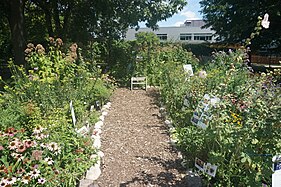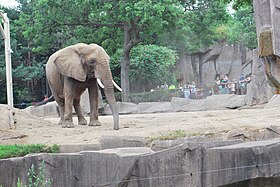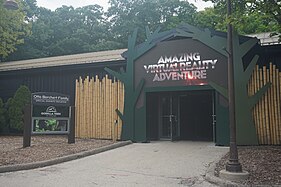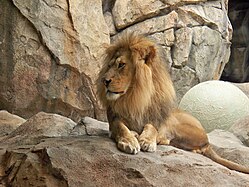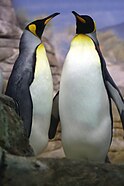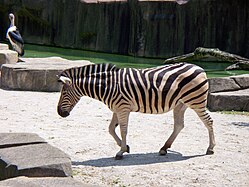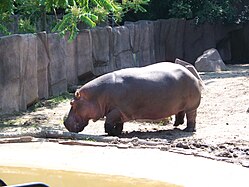Milwaukee County Zoo
| Milwaukee County Zoo | |
|---|---|
 | |
 Main Entrance | |
 | |
| 43°1′57.5724″N 88°2′14.64″W / 43.032659000°N 88.0374000°W | |
| Date opened | January 16, 1892 (Washington Park site) May 13, 1961 (current site)[1] |
| Location | 10001 W. Bluemound Rd. Milwaukee, Wisconsin |
| Land area | 200 acres (81 ha)[1] |
| No. of animals | 3,100[2] |
| No. of species | 350[2] |
| Annual visitors | 1.3 million[2] |
| Memberships | Association of Zoos and Aquariums[3] |
| Major exhibits | Aviary Apes of Africa/Primates of the World Aquatic and Reptile Center Small Mammal Building Large Mammals Northwestern Mutual Family Farm |
| Public transit access | |
| Website | www |
The Milwaukee County Zoo is a
History
The Washington Park Zoo

The
Even with the
The Milwaukee County Zoo

Although still located in
Later additions included the aviary (1962),[24] the Australian building (1963), the original animal hospital (1963),[25] the small mammal building (1965), the aquarium (1968), and the reptile building (1968).[26] In 1965, four Zoomobile tour trains were donated by Allis-Chalmers.[27] This was followed by the children's zoo (1971),[28] and the polar bear underwater viewing exhibit (1986).[29] In 1986, the children's zoo was renamed the Stackner Heritage Farm, and a dairy complex was constructed as part of it, to celebrate Wisconsin as America's Dairyland. The complex included a cow barn, education center, and dairy store.[30] In 1988, the Taylor Family Humboldt penguin exhibit, the education center, and the Peck Welcome Center opened.[31]

In the following years, the renovated sea lion exhibit, featuring underwater viewing, opened,[32] and the aviary was renovated.[33] More recent changes include the addition of the Sterns Family Apes of Africa exhibit (1992),[34] the renovation of the aquarium and reptile building (now known as the Aquatic and Reptile Center),[35] the renovation of the small mammal building (1998), and the addition of the Wong Family Pheasantry (1998).[36] In 2002, Monkey Island was renovated to include a large deck for viewing, and was renamed Macaque Island.[37] 2003 saw a newly remodeled animal health center;[38] 2004, a new education center;[39] and 2005 and 2006, the remodeling of the Heritage Farm, feline building, and giraffe exhibit.[40][41]
The zoo's newest construction plan was a new West Entrance with a gift shop and a new North American river otter exhibit, due to the small size of the existing tank in the Small Mammal House building, in addition a new parking lot, in order to facilitate reconstruction and reconfiguration due to the rebuilding of the Zoo Interchange to the southeast of the zoo property by the Wisconsin Department of Transportation.[42]
Exhibits
Taylor Family Humboldt Penguin Pool
This is an exhibit near the zoo's Main Entrance. This fifteen-thousand gallon tank features a group of
Herb and Nada Mahler Family Aviary

The
Stearns Family Apes of Africa
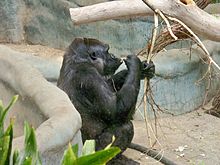
Opened in 1992 at the cost of $10.7 million, this indoor building features a large troop of bonobos and gorillas.[44] The zoo maintains a bonobo breeding program with one of the largest collections of bonobos in professional care in the world.[47] Both species have access to indoor and outdoor exhibits.
As of 2018, the zoo will have a total of four Western lowland gorillas, after the death of 31-year-old dominant male Cassius and 17-year-old Naku in April.[48]
Primates of the World
Adjacent to Apes of Africa, this exhibit showcases
Macaque Island
Macaque Island features a troop of Japanese macaques. It is a large mountain surrounded by water. It was remodeled in 2002 to include a large viewing deck for zoo guests and an expanded shelter for the resident macaques, with waterfalls and a larger mountain.[37]
Aquatic and Reptile Center
This building holds
Small Mammal Building
This building, located near the Aquatic and Reptile Center, features a special room for nocturnal species that is darkened in the day and brightened at night so the animals live on a schedule friendly to zoo visitors. Residents include
North America

A series of outdoor exhibits themed around the megafauna of the North American continent featuring
Many of these species like the reindeer and the grizzlys are displayed in predator-prey "panorama" exhibits, which make them appear to share the space via a hidden moat.Northwestern Mutual Family Farm
The newly renovated children's zoo with a focus on native midwestern United States wildlife and educational presentations, featuring species such as
Africa/Asia/South America Mixed Exhibits

A series out of outdoor exhibits featuring animals from
South American species include
Adventure Africa

Adventure Africa phases 1 and 2 opened in spring of 2019 and the summer of 2020. The first phase is a new home for
Adventure Africa phase 3 will be the final phase to the adventure Africa master plan, and it will include a new exhibit that will have a conversion to the old elephant and current rhino habitats, and turn them it into a new space for the zoo's
Otter Passage
Opened in Spring 2018, the otter passage is home to a group of river otters in a large exhibit with two pools for underwater viewing. It opened alongside the new West Entrance and acts similar to the Taylor Family Humboldt Penguin Pool in that is an introduction exhibit depending on which entrance visitors choose to go through.
Otto Borchert Family Special Exhibits Gallery
This building is dedicated to special or traveling exhibits.[52][53]
Other Facilities
Safari Train

The 15 in (381 mm) gauge rideable miniature railway, first opened in 1958, continues to transport guests around the zoo when weather allows.
The railroad began operations using
The #82 was eventually withdrawn, due to being too small to pull the longer trains the zoo needed to handle the crowds, and was placed on display. In 1989, the zoo loaned #82 to the recently rebuilt Riverside and Great Northern Railway, and later traded the engine to the R&GN for a second diesel, #1992.[55]
In March 2024, it was announced that the two steam locomotives would be retired and replaced by two new diesel locomotives. The steam locomotives will be sold to the Riverside and Great Northern Railway.[56]
Child friendly areas
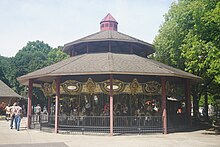
- Playground[57]
- Treehouse area[57]
- Dinosaur exhibit (seasonal)[57]
- Sky Trail® Ropes Courses & Zip Line[58]
- Ski Safari[58]
- Zoo Mobile[58]
- Penzeys Carousel
Gallery
-
Butterfly Garden
-
African elephant (Loxodonta)
-
Giraffes at the zoo
-
Peacock
-
Otto Borchert Family Special Exhibits Building
-
Thomson's gazelle
-
Lion
-
King Penguin (Aptenodytes patagonicus)
-
Zebra
-
Hippo
References
- ^ a b "Milwaukee County Zoo-About Us". Milwaukeezoo.org. Retrieved December 17, 2011.
- ^ a b c d e Diliberti-Shea, Jennifer. "Go behind the scenes at the Milwaukee County Zoo to be educated and entertained". Milwaukee Journal Sentinel.
- ^ a b "Currently Accredited Zoos and Aquariums". AZA.org. Association of Zoos and Aquariums (AZA).
- ^ "Media: Zoo Facts | Milwaukee County Zoo". www.milwaukeezoo.org. Retrieved December 12, 2018.
- ^ "International Polar Bear Husbandry Conference Proceedings". Archived from the original on June 21, 2006. Retrieved August 15, 2007.
- ^ "The New Milwaukee County Zoo ~ 1961–1984 – 1962". Archived from the original on January 12, 2010. Retrieved August 15, 2007.
- ^ "Animal-Human Relations | Encyclopedia of Milwaukee". emke.uwm.edu. Retrieved January 27, 2018.
- ^ "Animal Division: Individual Conservation and Research Projects – Bonobos". Archived from the original on July 3, 2008. Retrieved August 15, 2007.
- ^ "Meet the Zoo's Cheetahs". Archived from the original on July 16, 2007. Retrieved August 15, 2007.
- ^ "Building the Washington Park Zoo ~ 1892–1927 – 1892". Archived from the original on January 12, 2010. Retrieved November 27, 2011.
- ^ "1893". Milwaukeezoo.org. Archived from the original on June 11, 2010. Retrieved December 17, 2011.
- ^ "1899". Milwaukeezoo.org. Archived from the original on June 11, 2010. Retrieved December 17, 2011.
- ^ "1900". Milwaukeezoo.org. Archived from the original on June 11, 2010. Retrieved December 17, 2011.
- ^ "1902". Milwaukeezoo.org. Archived from the original on June 11, 2010. Retrieved December 17, 2011.
- ^ "1930". Milwaukeezoo.org. Archived from the original on June 11, 2010. Retrieved December 17, 2011.
- ^ "1931". Milwaukeezoo.org. Archived from the original on June 11, 2010. Retrieved December 17, 2011.
- ^ "1937". Milwaukeezoo.org. Archived from the original on June 11, 2010. Retrieved December 17, 2011.
- ^ "1942". Milwaukeezoo.org. Archived from the original on June 11, 2010. Retrieved December 17, 2011.
- ^ "1947". Milwaukeezoo.org. Archived from the original on June 11, 2010. Retrieved December 17, 2011.
- ^ "1953". Milwaukeezoo.org. Archived from the original on June 11, 2010. Retrieved December 17, 2011.
- ^ "1958". Milwaukeezoo.org. Archived from the original on June 11, 2010. Retrieved December 17, 2011.
- ^ "1959". Milwaukeezoo.org. Archived from the original on January 13, 2010. Retrieved December 17, 2011.
- ^ "1961". Milwaukeezoo.org. Archived from the original on January 25, 2010. Retrieved December 17, 2011.
- ^ "1962". Milwaukeezoo.org. Archived from the original on January 12, 2010. Retrieved December 17, 2011.
- ^ "1963". Milwaukeezoo.org. Archived from the original on June 11, 2010. Retrieved December 17, 2011.
- ^ "1968". Milwaukeezoo.org. Archived from the original on June 11, 2010. Retrieved December 17, 2011.
- ^ "1965". Milwaukeezoo.org. Archived from the original on June 11, 2010. Retrieved December 17, 2011.
- ^ "1971". Milwaukeezoo.org. Archived from the original on January 15, 2010. Retrieved December 17, 2011.
- ^ "1986". Milwaukeezoo.org. Archived from the original on June 11, 2010. Retrieved December 17, 2011.
- ^ "1987". Milwaukeezoo.org. Archived from the original on June 11, 2010. Retrieved December 17, 2011.
- ^ "1988". Milwaukeezoo.org. Archived from the original on June 11, 2010. Retrieved December 17, 2011.
- ^ "1990". Milwaukeezoo.org. Archived from the original on January 13, 2010. Retrieved December 17, 2011.
- ^ "1991". Milwaukeezoo.org. Archived from the original on June 11, 2010. Retrieved December 17, 2011.
- ^ "1992". Milwaukeezoo.org. Archived from the original on June 11, 2010. Retrieved December 17, 2011.
- ^ "1995". Milwaukeezoo.org. Archived from the original on January 15, 2010. Retrieved December 17, 2011.
- ^ "1998". Milwaukeezoo.org. Archived from the original on June 11, 2010. Retrieved December 17, 2011.
- ^ a b "2002". Milwaukeezoo.org. Archived from the original on June 11, 2010. Retrieved December 17, 2011.
- ^ "2003". Milwaukeezoo.org. Archived from the original on January 13, 2010. Retrieved December 17, 2011.
- ^ "2004". Milwaukeezoo.org. Archived from the original on January 15, 2010. Retrieved December 17, 2011.
- ^ a b "2005". Milwaukeezoo.org. Archived from the original on June 11, 2010. Retrieved December 17, 2011.
- ^ a b "2006". Milwaukeezoo.org. Archived from the original on January 16, 2010. Retrieved December 17, 2011.
- ^ "Milwaukee County Zoo Plans $7 million New West Entrance". BizJournals.com. Retrieved August 4, 2014.
- ^ "Meet the Animals: Taylor Family Humboldt Penguin Exhibit". Archived from the original on July 17, 2019. Retrieved February 16, 2020.
- ^ a b c d "Listings of Animals". Milwaukeezoo.org. Archived from the original on October 26, 2010. Retrieved December 17, 2011.
- ^ "WANT TO GET AWAY THIS WINTER?". Milwaukee Zoo. November 2012. Retrieved October 9, 2019.
- ^ a b c d e f g h "Milwaukee County Zoo Animals" (PDF). Milwaukeezoo.org. Retrieved August 4, 2014.
- ^ "Milwaukeezoo.org". Archived from the original on January 30, 2012. Retrieved February 29, 2012.
- ^ "Milwaukee County Zoo's baby gorilla will be moved to a different zoo".
- ^ "Memories of Samson the Gorilla". Zoological Society of Milwaukee. Retrieved February 29, 2012.
- ^ "THE MILWAUKEE COUNTY ZOO TO OPEN ADVENTURE AFRICA PHASE I: ELEPHANT EXHIBIT". Archived from the original on August 5, 2019. Retrieved February 16, 2020.
- ^ "ADVENTURE AFRICA PHASE I: ELEPHANT EXHIBIT". Archived from the original on July 27, 2019. Retrieved February 16, 2020.
- ^ "More than 500 butterflies flutter in new Zoo exhibit". OnMilwaukee. Retrieved October 9, 2019.
- ^ "Milwaukee Zoo To Debut LEGO-Inspired Dinosaur Exhibit". Patch. May 17, 2019. Retrieved October 9, 2019.
- ^ "Sandley Light Railway Equipment Co". donsdepot.donrossgroup.net. Retrieved November 5, 2018.
- ^ "Archived copy" (PDF). Archived from the original (PDF) on June 24, 2016. Retrieved September 16, 2017.
{{cite web}}: CS1 maint: archived copy as title (link) - ^ "Milwaukee County Zoo railroad replacing steam engines". Trains. March 15, 2024. Retrieved March 16, 2024.
- ^ a b c Schwabe, Amy (June 29, 2018). "From a Mold-a-Rama souvenir to a baby animal tour, here's what you can do with your kids at the Milwaukee County Zoo". JSonline.com. Retrieved June 22, 2019.
- ^ a b c "HAVE A WILD TIME!". Milwaukee Zoo. Milwaukee County Zoo. Retrieved June 22, 2019.

